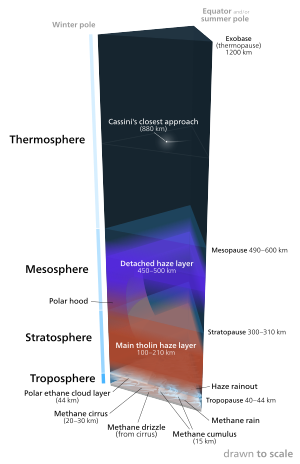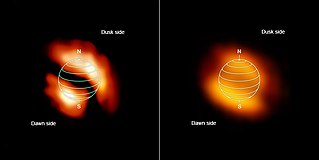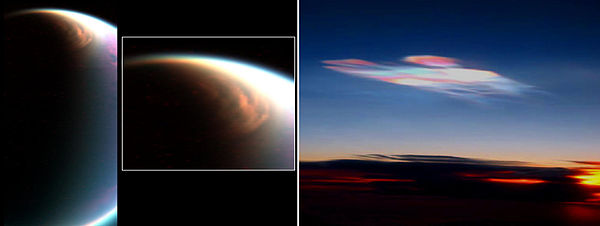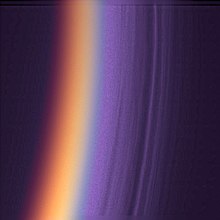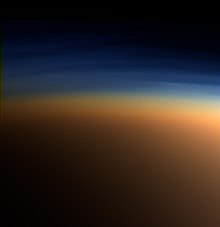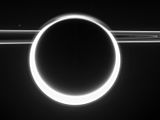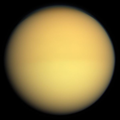
True-color image of layers of haze in Titan's atmosphere
| |
| General information | |
|---|---|
| Chemical species | Molar fraction |
| Composition | |
| Nitrogen | 94.2% |
| Methane | 5.65% |
| Hydrogen | 0.099% |
The atmosphere of Titan is the layer of gases surrounding Titan, the largest moon of Saturn. It is the only thick atmosphere of a natural satellite in the Solar System. Titan's lower atmosphere is primarily composed of nitrogen (94.2%), methane (5.65%), and hydrogen (0.099%). There are trace amounts of other hydrocarbons, such as ethane, diacetylene, methylacetylene, acetylene, propane, PAHs and of other gases, such as cyanoacetylene, hydrogen cyanide, carbon dioxide, carbon monoxide, cyanogen, acetonitrile, argon and helium. The isotopic study of nitrogen isotopes ratio also suggest acetonitrile may be present in quantities exceeding hydrogen cyanide and cyanoacetylene. The surface pressure is about 50% higher than Earth at 1.5 bars which is near the triple point of methane and allows there to be gaseous methane in the atmosphere and liquid methane on the surface. The orange color as seen from space is produced by other more complex chemicals in small quantities, possibly tholins, tar-like organic precipitates.
Observational history
The presence of a significant atmosphere was first suspected by Spanish astronomer Josep Comas i Solà, who observed distinct limb darkening on Titan in 1903, and confirmed by Gerard P. Kuiper in 1944 using a spectroscopic technique that yielded an estimate of an atmospheric partial pressure of methane of the order of 100 millibars (10 kPa).
Subsequent observations in the 1970s showed that Kuiper's figures had
been significant underestimates; methane abundances in Titan's
atmosphere were ten times higher, and the surface pressure was at least
double what he had predicted. The high surface pressure meant that
methane could only form a small fraction of Titan's atmosphere. In 1980, Voyager 1
made the first detailed observations of Titan's atmosphere, revealing
that its surface pressure was higher than Earth's, at 1.5 bars (about
1.48 times that of Earth's).
The joint NASA/ESA Cassini-Huygens
mission provided a wealth of information about Titan, and the Saturn
system in general, since entering orbit on July 1, 2004. It was
determined that Titan's atmospheric isotopic abundances were evidence
that the abundant nitrogen in the atmosphere came from materials in the Oort cloud, associated with comets, and not from the materials that formed Saturn in earlier times. It was determined that complex organic chemicals could arise on Titan, including polycyclic aromatic hydrocarbons, propylene, and methane.
The Dragonfly mission by NASA is planning to land a large aerial vehicle on Titan in 2034. The mission will study Titan's habitability and prebiotic chemistry at various locations. The drone-like aircraft will perform measurements of geologic processes, and surface and atmospheric composition.
Overview
Observations from the Voyager space probes have shown that the Titanean atmosphere is denser than Earth's, with a surface pressure about 1.48 times that of Earth's. Titan's atmosphere is about 1.19 times as massive as Earth's overall,
or about 7.3 times more massive on a per surface area basis. It
supports opaque haze layers that block most visible light from the Sun
and other sources and renders Titan's surface features obscure. The
atmosphere is so thick and the gravity so low that humans could fly
through it by flapping "wings" attached to their arms. Titan's lower gravity means that its atmosphere is far more extended than Earth's; even at a distance of 975 km, the Cassini spacecraft had to make adjustments to maintain a stable orbit against atmospheric drag. The atmosphere of Titan is opaque at many wavelengths and a complete reflectance spectrum of the surface is impossible to acquire from the outside. It was not until the arrival of Cassini–Huygens in 2004 that the first direct images of Titan's surface were obtained. The Huygens
probe was unable to detect the direction of the Sun during its descent,
and although it was able to take images from the surface, the Huygens team likened the process to "taking pictures of an asphalt parking lot at dusk".
Vertical structure
Titan's vertical atmospheric structure is similar to Earth.
They both have a troposphere, stratosphere, mesosphere, and
thermosphere. However, Titan's lower surface gravity creates a more
extended atmosphere, with scale heights of 15-50 km in comparison to 5-8 km on Earth. Voyager data, combined with data from Huygens and radiative-convective models provide increased understanding of Titan's atmospheric structure.
- Troposphere: This is the layer where a lot of the weather occurs on Titan. Since methane condenses out of Titan's atmosphere at high altitudes, its abundance increases below the tropopause at an altitude of 32 km, leveling off at a value of 4.9% between 8 km and the surface. Methane rain, haze rainout, and varying cloud layers are found in the troposphere.
- Stratosphere: The atmospheric composition in the stratosphere is 98.4% nitrogen—the only dense, nitrogen-rich atmosphere in the Solar System aside from Earth's—with the remaining 1.6% composed mostly of methane (1.4%) and hydrogen (0.1–0.2%). The main tholin haze layer lies in the stratosphere at about 100-210 km. In this layer of the atmosphere there is a strong temperature inversion caused by the haze due to a high ratio of shortwave to infrared opacity.
- Mesosphere: A detached haze layer is found at about 450-500 km, within the mesosphere. The temperature at this layer is similar to that of the thermosphere because of the cooling of hydrogen cyanide (HCN) lines.
- Thermosphere: Particle production begins in the thermosphere This was concluded after finding and measuring heavy ions and particles. This was also Cassini's closest approach in Titan's atmosphere.
- Ionosphere: Titan's ionosphere is also more complex than Earth's, with the main ionosphere at an altitude of 1,200 km but with an additional layer of charged particles at 63 km. This splits Titan's atmosphere to some extent into two separate radio-resonating chambers. The source of natural extremely-low-frequency (ELF) waves on Titan, as detected by Cassini–Huygens, is unclear as there does not appear to be extensive lightning activity.
Atmospheric composition and chemistry
Titan's
atmospheric chemistry is diverse and complex. Each layer of the
atmosphere has unique chemical interactions occurring within that are
then interacting with other sub layers in the atmosphere. For instance,
the hydrocarbons are thought to form in Titan's upper atmosphere in
reactions resulting from the breakup of methane by the Sun's ultraviolet light, producing a thick orange smog.
The table below highlights the production and loss mechanisms of the
most abundant photochemically produced molecules in Titan's atmosphere.
| Molecule | Production | Loss |
|---|---|---|
| Hydrogen | Methane photolysis | Escape |
| Carbon Monoxide | ||
| Ethane | Condensation | |
| Acetylene | Condensation | |
| Propane | Condensation | |
| Ethylene | ||
| Hydrogen Cyanide | Condensation | |
| Carbon Dioxide | Condensation | |
| Methylacetylene | ||
| Diacetylene |
A cloud imaged in false color over Titan's north pole.
Magnetic field
Titan has no magnetic field,
although studies in 2008 showed that Titan retains remnants of Saturn's
magnetic field on the brief occasions when it passes outside Saturn's magnetosphere and is directly exposed to the solar wind. This may ionize and carry away some molecules from the top of the atmosphere. Titan's internal magnetic field is negligible, and perhaps even nonexistent. Its orbital distance of 20.3 Saturn radii does place it within Saturn's magnetosphere occasionally. However, the difference between Saturn's rotational period (10.7 hours) and Titan's orbital period (15.95 days) causes a relative speed of about 100 km/s between the Saturn's magnetized plasma and Titan. That can actually intensify reactions causing atmospheric loss, instead of guarding the atmosphere from the solar wind.
Chemistry of the ionosphere
In November 2007, scientists uncovered evidence of negative ions with
roughly 13 800 times the mass of hydrogen in Titan's ionosphere, which
are thought to fall into the lower regions to form the orange haze which
obscures Titan's surface. The smaller negative ions have been identified as linear carbon chain anions with larger molecules displaying evidence of more complex structures, possibly derived from benzene. These negative ions appear to play a key role in the formation of more complex molecules, which are thought to be tholins, and may form the basis for polycyclic aromatic hydrocarbons, cyanopolyynes
and their derivatives. Remarkably, negative ions such as these have
previously been shown to enhance the production of larger organic
molecules in molecular clouds beyond our Solar System, a similarity which highlights the possible wider relevance of Titan's negative ions.
Titan's South Pole Vortex—a swirling HCN gas cloud (November 29, 2012).
Atmospheric circulation
There is a pattern of air circulation found flowing in the direction
of Titan's rotation, from west to east. In addition, seasonal variation
in the atmospheric circulation have also been detected. Observations by Cassini of the atmosphere made in 2004 also suggest that Titan is a "super rotator", like Venus, with an atmosphere that rotates much faster than its surface. The atmospheric circulation is explained by a big Hadley circulation that is occurring from pole to pole.
Methane cycle
Energy
from the Sun should have converted all traces of methane in Titan's
atmosphere into more complex hydrocarbons within 50 million years — a
short time compared to the age of the Solar System. This suggests that
methane must be somehow replenished by a reservoir on or within Titan
itself. Most of the methane on Titan is in the atmosphere. Methane is
transported through the cold trap at the tropopause.
Therefore the circulation of methane in the atmosphere influences the
radiation balance and chemistry of other layers in the atmosphere. If
there is a reservoir of methane on Titan, the cycle would only be stable
over geologic timescales.
Evidence that Titan's atmosphere contains over a thousand times more methane than carbon monoxide
would appear to rule out significant contributions from cometary
impacts, because comets are composed of more carbon monoxide than
methane. That Titan might have accreted an atmosphere from the early
Saturnian nebula at the time of formation also seems unlikely; in such a
case, it ought to have atmospheric abundances similar to the solar
nebula, including hydrogen and neon.
Many astronomers have suggested that the ultimate origin for the
methane in Titan's atmosphere is from within Titan itself, released via
eruptions from cryovolcanoes.
Daytime and Twilight (sunrise/sunset) Skies
Sky brightness models of a sunny day on Titan. The Sun is seen setting from noon until after dusk at 3 wavelengths: 5 μm, near-infrared (1-2 μm), and visible.
Each image shows a "rolled-out" version of the sky as seen from the
surface of Titan. The left side shows the Sun, while the right side
points away from the Sun. The top and bottom of the image are the zenith and the horizon respectively. The solar zenith angle represents the angle between the Sun and zenith (0°), where 90° is when the Sun reaches the horizon.
Sky brightness and viewing conditions are expected to be quite
different from Earth and Mars due to Titan's farther distance from the
Sun (~10 AU)
and complex haze layers in its atmosphere. The sky brightness model
videos show what a typical sunny day may look like standing on the
surface of Titan based on radiative transfer models.
For astronauts who see with visible light, the daytime sky has a distinctly dark orange color and appears uniform in all directions due to significant Mie scattering from the many high-altitude haze layers. The daytime sky is calculated to be ~100-1000 times dimmer than an afternoon on Earth, which is similar to the viewing conditions of a thick smog or dense fire smoke. The sunsets on Titan are expected to be "underwhelming events", where the Sun disappears about half-way up in the sky (~50° above the horizon)
with no distinct change in color. After that, the sky will slowly
darken until it reaches night. However, the surface is expected to
remain as bright as the full Moon up to 1 Earth day after sunset.
In near-infrared light, the sunsets resemble a Martian sunset or dusty desert sunset. Mie scattering
has a weaker influence at longer infrared wavelengths, allowing for
more colorful and variable sky conditions. During the daytime, the Sun
has a noticeable solar corona that transitions color from white to "red" over the afternoon. The afternoon sky brightness is ~100 times dimmer than Earth.
As evening time approaches, the Sun is expected to disappear fairly
close to the horizon. Titan's atmospheric optical depth is the lowest at
5 microns. So, the Sun at 5 microns may even be visible when it is below the horizon due to atmospheric refraction. Similar to images to Martian sunsets from Mars rovers, a fan-like corona is seen to develop above the Sun due to scattering from haze or dust at high-altitudes.
From outer space, Cassini images from near-infrared to UV wavelengths have shown that the twilight periods (sunrise/sunset) are brighter than the daytime on Titan. Scientists expect that planetary brightness will weaken going from the day to night side of the planetary body, known as the terminator. This paradoxical observation has not been observed on any other planetary body with a thick atmosphere.
The Titanean twilight outshining the dayside is likely due to a
combination of Titan's atmosphere extending hundreds of kilometers above
the surface and intense forward Mie scattering from the haze. Radiative transfer models have not reproduced this effect.
Atmospheric evolution
The persistence of a dense atmosphere on Titan has been enigmatic as the atmospheres of the structurally similar satellites of Jupiter, Ganymede and Callisto,
are negligible. Although the disparity is still poorly understood, data
from recent missions have provided basic constraints on the evolution
of Titan's atmosphere.
Layers of atmosphere, image from the Cassini spacecraft
Roughly speaking, at the distance of Saturn, solar insolation and solar wind flux are sufficiently low that elements and compounds that are volatile on the terrestrial planets tend to accumulate in all three phases. Titan's surface temperature is also quite low, about 94 K. Consequently, the mass fractions of substances that can become atmospheric constituents are much larger on Titan than on Earth. In fact, current interpretations suggest that only about 50% of Titan's mass is silicates, with the rest consisting primarily of various H2O (water) ices and NH3·H2O (ammonia hydrates). NH3, which may be the original source of Titan's atmospheric N2 (dinitrogen), may constitute as much as 8% of the NH3·H2O mass. Titan is most likely differentiated into layers, where the liquid water layer beneath ice Ih may be rich in NH3.
True-color image of layers of haze in Titan's atmosphere
Titan's atmosphere backlit by the Sun, with Saturn's rings behind. An outer haze layer merges at top with the northern polar hood.
Titan's winter hemisphere (top) is slightly darker in visible light due to a high-altitude haze
Tentative constraints are available, with the current loss mostly due to low gravity and solar wind aided by photolysis. The loss of Titan's early atmosphere can be estimated with the 14N–15N isotopic ratio, because the lighter 14N is preferentially lost from the upper atmosphere under photolysis and heating. Because Titan's original 14N–15N ratio is poorly constrained, the early atmosphere may have had more N2 by factors ranging from 1.5 to 100 with certainty only in the lower factor. Because N2 is the primary component (98%) of Titan's atmosphere, the isotopic ratio suggests that much of the atmosphere has been lost over geologic time.
Nevertheless, atmospheric pressure on its surface remains nearly 1.5
times that of Earth as it began with a proportionally greater volatile
budget than Earth or Mars. It is possible that most of the atmospheric loss was within 50 million years of accretion, from a highly energetic escape of light atoms carrying away a large portion of the atmosphere (hydrodynamic escape). Such an event could be driven by heating and photolysis effects of the early Sun's higher output of X-ray and ultraviolet (XUV) photons.
Because Callisto and Ganymede
are structurally similar to Titan, it is unclear why their atmospheres
are insignificant relative to Titan's. Nevertheless, the origin of
Titan's N2 via geologically ancient photolysis of accreted and degassed NH3, as opposed to degassing of N2 from accretionary clathrates, may be the key to a correct inference. Had N2 been released from clathrates, 36Ar and 38Ar that are inert primordial isotopes of the Solar System should also be present in the atmosphere, but neither has been detected in significant quantities. The insignificant concentration of 36Ar and 38Ar also indicates that the ~40 K temperature required to trap them and N2 in clathrates did not exist in the Saturnian sub-nebula. Instead, the temperature may have been higher than 75 K, limiting even the accumulation of NH3 as hydrates.
Temperatures would have been even higher in the Jovian sub-nebula due
to the greater gravitational potential energy release, mass, and
proximity to the Sun, greatly reducing the NH3 inventory accreted by Callisto and Ganymede. The resulting N2 atmospheres may have been too thin to survive the atmospheric erosion effects that Titan has withstood.
An alternative explanation is that cometary impacts release more energy on Callisto and Ganymede than they do at Titan due to the higher gravitational field of Jupiter.
That could erode the atmospheres of Callisto and Ganymede, whereas the
cometary material would actually build Titan's atmosphere. However, the 2H–1H (i.e. D–H) ratio of Titan's atmosphere is (2.3±0.5)×10−4, nearly 1.5 times lower than that of comets. The difference suggests that cometary material is unlikely to be the major contributor to Titan's atmosphere. Titan's atmosphere also contains over a thousand times more methane than carbon monoxide
which supports the idea that cometary material is not a likely
contributor since comets are composed of more carbon monoxide than
methane.
Titan - three dust storms detected in 2009-2010.
